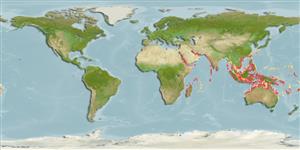Classification / Names
Common names from other countries
Main reference
Size / Weight / Age
Max length : 11.0 cm SL male/unsexed; (Ref. 48637)
Environment
Marine; reef-associated; depth range 6 - 40 m (Ref. 48637)
Climate / Range
Tropical, preferred ?
Distribution
Indo-Pacific: Kenya, Madagascar, Red Sea, Persian Gulf, Sri Lanka, Born Island, Andaman Sea; Guadalcanal, Solomons; Flores, Indonesia; south to the Great Barrier Reef.
Countries | FAO areas | Ecosystems | Occurrences | Introductions
Short description
Dorsal
spines
(total): 7;
Dorsal
soft rays
(total): 13;
Anal
spines: 1;
Anal
soft rays: 13. Characterized by whitish body color; snout and cheek with pair of thin, slanting dark brown bands, five wider brown bands on side with few brown spots between each band; anal fin yellow with blue margin; low basal membrane joins pelvic fins; predorsal scales extending forward to above posterior margin of preopercle; longitudinal scale series 67-75; greatest depth of body 5.2-6.7 in SL; caudal fin 2.8-3.6 in SL (Ref. 90102).
IUCN Red List Status (Ref. 115185)
Threat to humans
Harmless
Human uses
More information
Common namesSynonymsMetabolismPredatorsEcotoxicologyReproductionMaturitySpawningFecundityEggsEgg development
ReferencesAquacultureAquaculture profileStrainsGeneticsAllele frequenciesHeritabilityDiseasesProcessingMass conversion
Tools
Special reports
Download XML
Internet sources
Estimates of some properties based on models
Phylogenetic diversity index
PD50 = 0.5000 many relatives (e.g. carps) 0.5 - 2.0 few relatives (e.g. lungfishes)
Trophic Level
3.4 ±0.3 se; Based on size and trophs of closest relatives
Resilience
High, minimum population doubling time less than 15 months (Preliminary K or Fecundity.)
Vulnerability
Low to moderate vulnerability (27 of 100)
Price category
